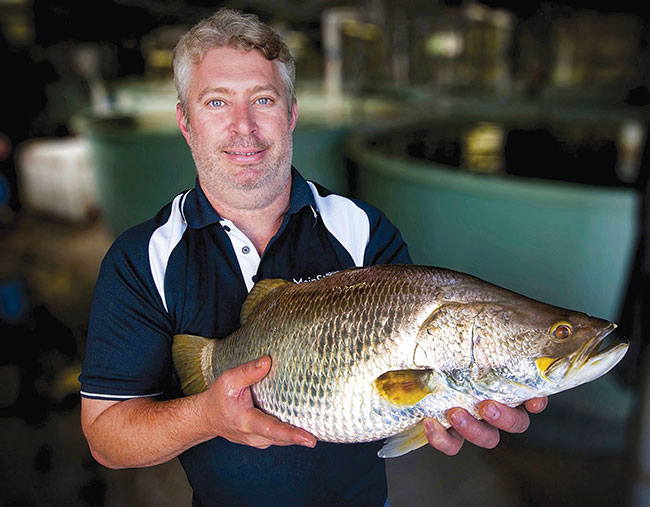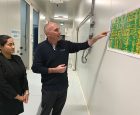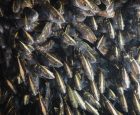
Features
Breeding
Business Management
Profiles
Banking on Barramundi
After more than a decade of developing its selective breeding program, one Australian company is now reaping the benefits.
September 13, 2019 By John Mosig
 MainStream’s chief scientist Dr. Paul Harrison with one of MainStream’s barramundi broodstock.
MainStream’s chief scientist Dr. Paul Harrison with one of MainStream’s barramundi broodstock. MainStream Aquaculture currently produces over 30 per cent of the world’s commercial barramundi (Lates calcarifer) seedstock, including exclusive supply to seven of the world’s 10 largest producers. The company’s intensive R&D program has been significant in its ability to serve the global market with improved barramundi fingerlings. Through a selective breeding program that was developed 12 years ago, on-farm productivity has increased substantially through better growth and survival rates.
MainStream’s flagship hatchery in Wyndham, Australia, can produce three million fry per month. Capacity was increased to six million per month in 2018 with the addition of another four broodstock systems and a large-scale larval room. MainStream is currently developing a third satellite hatchery to complement its R&D hatchery, which is located in Townsville, Australia.
Following multiple generations of successful selective breeding, MainStream embarked on a partnership with leading farms throughout the industry to accelerate its breeding program and to customise fingerling production for selected farming environments.
As chief scientist Dr. Paul Harrison explained, “We’re part of the CRC-Project (Cooperative Research Centre) Rapid iteration selective breeding: Australia’s ‘fish to feed the world’ – which is partnered with Sealord, Pejo Enterprises, Marine Produce Australia and Barramundi Asia. By accessing the knowledge from our breeding program, broodstock pairs can be identified to produce the next generation of offspring that are best suited for specific grow-out environments. Each grow-out environment is unique and all are influenced by a range of environmental factors, such as the level of salinity, water temperature and even tidal flows. Through genotype by environment experiments and data analysis, we will be able to select fingerlings that are going to be the most robust in a particular environment.”
It’s genetics
The on-going nature of the selection program at Maintream is a clear demonstration of the amount of resources they’ve been prepared to invest.
“It’s not good enough just to have an individually good fish,” says Harrison. “It’s the parental combination and family that’s important. What we’ve actually achieved over the last twelve years is a marked improvement in the performance of commercial cohorts, predominantly by identifying which parents contribute to poor growing fish and removing them from the breeding population.”
In addition, the MainStream team is also trying to identify broodstock families that outperform the mean and are superior for traits such as fast growth, Harrison explains. “We have really good evidence that we’ve developed a truly domesticated genotype, far removed from the wild fish. The larger, more sophisticated farms around the world are starting to pick up the benefits from these selectively improved, calmer, genetically fit offspring. We have a lot of repeat business because of the performance attributes of our fish.”
While growth rates are a base measure of genetic improvement, Harrison points out that the economic gains went deeper than that.
“The quality fish we produce has increased dramatically. They demonstrate much narrower bell curves, which is commercially more valuable than outright increases in growth rates because we are interested in the performance of the entire cohort. Now our production cycles are more predictable with a tighter size range. Grading is a cost bearing operation on the business and this has also been minimized.”
That said, growth rate improvements are in the order of 30 to 35 per cent and the MainStream lines of seedstock consistently produce the deep, thick-bodied fish favoured by the market.
Having reached this level of genetic sophistication, MainStream is now in a position to adapt lines even more sharply focused on individual situations; particularly around disease resistance.
“That’s actually the biggest challenge in other parts of the world, especially in Asia. Here in Australia we don’t tend to have the same level of disease challenges. Our increased production capacity has enabled us to dedicate a stream of research strands to breeding a robust fish tailored to counter specific diseases and environmental issues confronting different customers.”
Ahead of its time
Production, beginning in the hatchery to the final phases of grow-out follows three main stages. After 50 days the fry are 0.5 grams and leave the hatchery for the nursey tanks where they spend approximately six weeks growing to 20 grams. Grading is conducted weekly at this stage, to minimize any size variation between groups and to control the natural tendency of barramundi to cannibalize.
From there, the cohort is transferred to the first grow-out stage in 80,000-litre tanks and grown to 100 grams, for approximately eight weeks. Their final move is to 600,000-litre tanks where they are grown to between 700 and 800 grams. Batches are closely monitored for superior performance.
Research and development officer, Dr. Shannon Loughnan is part of the team on the CRC-Project. “Now that we are able to employ the latest technology in genetic markers, we can perform a more sophisticated level of genomic selection and target traits with a higher level of resolution. In addition, our focus is to control inbreeding levels and maintain genetic diversity through the relationships of broodstock.”
This has also helped them maintain commercial balance within the aims of the CRC project. “In addition, climate change is an important factor that can influence the culture of barramundi, due to the impacts on pH, water temperature and salinity. By investigating genotype by environment interactions, the CRC-Project will provide a lot of development in this area,” Loughnan says.
“The single nucleotide polymorphism (SNP) marker panel developed for the CRC-Project will be an important tool in the acceleration of the breeding program and to develop superior seedstock for the industry,”
Mainstream’s breeding program is ahead of its time. The sophistication of the program is on par with the best programs being applied on developed species like salmon and tilapia, and there is now enormous opportunity worldwide for expansion of the barramundi industry.
At market, barramundi fills a much-needed gap in the premium white fish category and the ability to grow this fish worldwide is being fuelled by a highly reliable supply of domesticated stock selectively bred for optimised productivity across environments that include fresh, salt and brackish waters. By embarking on a bold, long-term investment strategy in research and development, MainStream Aquaculture has been able to significantly increase the production capability of barramundi and, in doing so, has been instrumental in taking the species to a new level globally.
For further information, contact Dr. Paul Harrison at paul@mainaqua.com.au
Print this page
Advertisement
- Russia spends US$12M to help restore fish populations
- Restricted translocations needed to preserve cleaner fish genetic diversity: study







